Buffalo MiniStation Thunderbolt Review - An External with USB 3.0 and Thunderbolt
by Brian Klug on August 1, 2012 4:04 PM EST- Posted in
- Storage
- SSDs
- USB 3.0
- Thunderbolt
- Buffalo
To test the MiniStation Thunderbolt I turned to a combination of Intech’s QuickBench and the BlackMagic Disk Speed Test application from the Mac App store. I tested on my 2011 MacBook Pro, which has a first generation Light Ridge Thunderbolt controller inside. For testing on OS X, I used native HFS+ formatting for the MiniStation.
| BlackMagic Disk Speed Test - 2011 MBP | |||||||
| 500 GB HDD | 240 GB OCZ Vertex 3 | ||||||
| Read (MB/s) | Write (MB/s) | Read (MB/s) | Write (MB/s) | ||||
| USB 2.0 | - | - | 28.4 | 34.7 | |||
| Thunderbolt | 112.5 | 110.9 | 269.8 | 370.5 | |||
There’s no USB 3.0 on my 2011 MacBook Pro, so for USB 3.0 I turned to my desktop which has a Renesas based USB 3.0 controller, and reformatted the drive to NTFS. I used CrystalDisk Mark to test.
With the HDD inside, you basically get the kind of speeds you’d expect were the drive connected natively over SATA. Keep in mind, with the 1 TB HDD, speeds will actually be slightly higher thanks to the higher storage density.
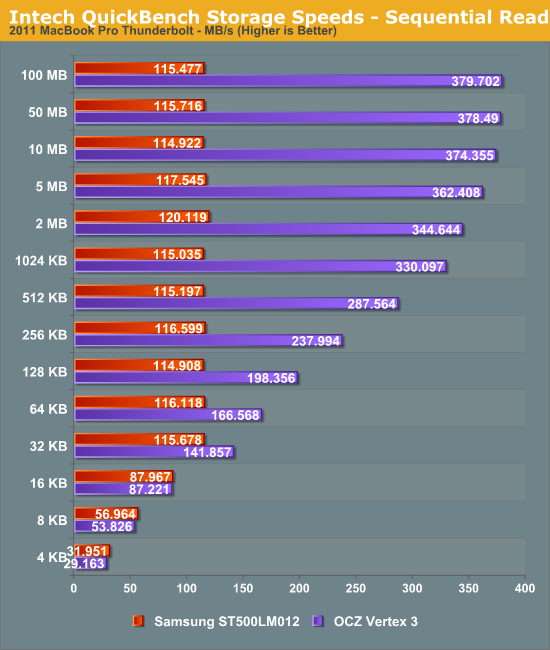
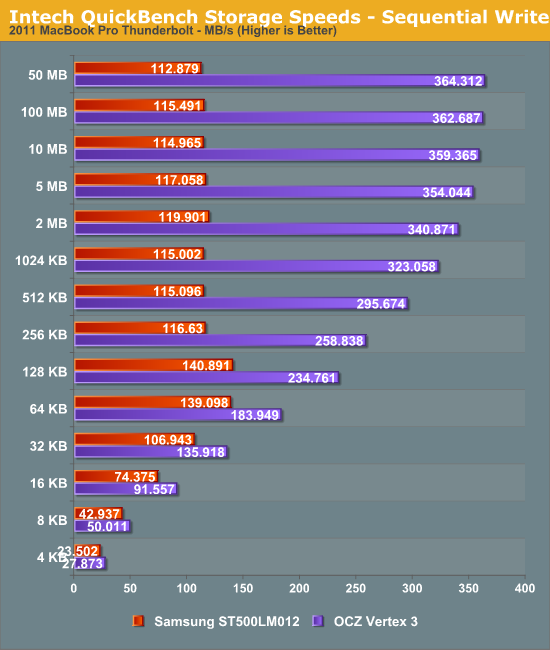
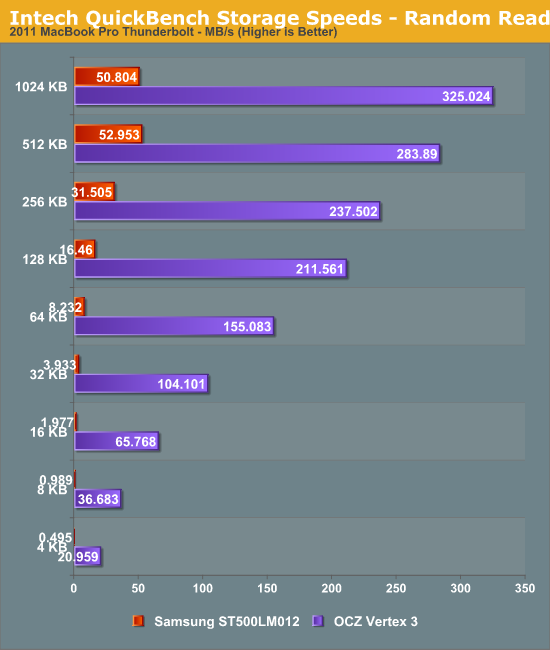
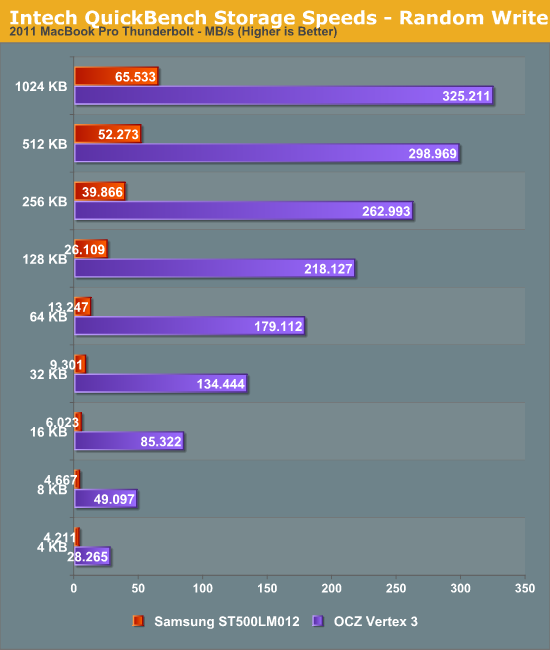

Looking at the QuickBench scores, the Vertex 3 performs just as well inside the MiniStation as it does connected to a 6Gbps SATA controller in our Bench test bed.
When connected over Thunderbolt on OS X, in System Profiler you can see the drive attached over an AHCI controller just like any internal drive, and with TRIM enabler patched kexts on OSX you can even TRIM the SSD. Buffalo has no plans to sell a bare external enclosure for people to stick their own SSD in, but at the current price point upgrading it yourself is a pretty viable option.
In addition to stressing the drive with the BlackMagic Disk Speed Test app set to 50 GB, I filled the stock HDD with random data by running good ol’ dd with data from /dev/urandom, a favorite test of mine for all storage that comes my way. Just run “dd if=/dev/urandom of=test.bin” in the root of the drive, and let it fill up. The drive’s aluminum underside does a great job conducting heat away, and gets somewhat warm (after all, it is doubling as a heatsink, and aluminum has great thermal conductivity) during use. Even with hours of constant Thunderbolt and HDD access, the drive didn’t overheat or disconnect at all with the HDD inside. I’ve also stressed the drive with the SSD inside (an unsupported configuration) and didn’t encounter any issues.
Anand noted in his original Thunderbolt piece that the cable connectors at the endpoints get warm, and measured 27.6C at the end of a cable. I ended up measuring a notably warmer temperature of over 35C during my stress testing of the drive, but my ambient temperature in AZ is also hotter than Anand’s in NC. When you consider that there’s an active component at the end of both sides of the cable (a Gennum GN2033), this isn’t altogether surprising, but it is disconcerting to feel the cables get noticeably warm during use.


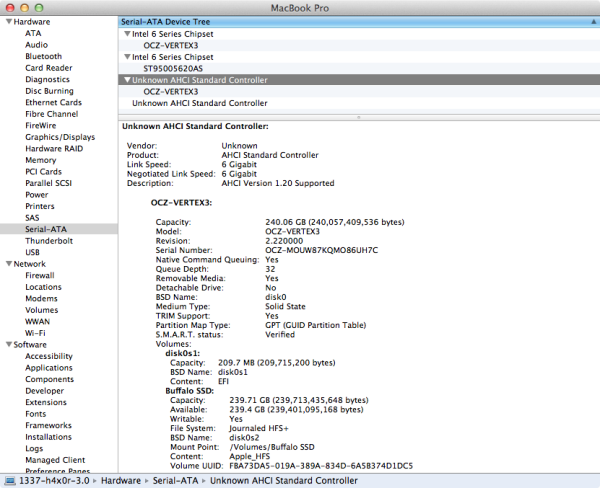









61 Comments
View All Comments
scubaboy - Friday, November 30, 2012 - link
No, because all of Apple's current lineup of machines, with the exception of the Mac Pro, have multiple (either 2 or 4) USB3 ports. In addition to 1 or 2 TB ports.http://www.apple.com/why-mac/compare/
Lonyo - Thursday, August 2, 2012 - link
It's not a loaded question.The drive has no passthrough, therefore you are ONLY able to connect a single harddrive.
It's irrelevant what Thunderbolt can potentially do as a port, the port itself becomes totally irrelevant once you close it off by connecting this drive.
It doesn't matter if the port can do display connections, or anything else. Once you connect this particular drive, it can't, it can just access this drive.
Which is exactly the same as a USB drive would be.
Yes, Thunderbolt has other uses, but none of them are relevant when you use a drive without passthrough. Unless you are connecting it to the other end of a Thunderbolt device which DOES have passthrough, you are simply using Thunderbolt in the exact same way you would use a USB3 port, meaning any port advantage whatsoever is nonexistent.
Which is also why I said "With THIS drive", meaning this specific drive, not Thunderbolt drives or devices in general.
And I said "this drive" more than once, to try and make it clear I meant THIS drive.
repoman27 - Thursday, August 2, 2012 - link
Well, you could put this drive at the end of a chain of other Thunderbolt devices. It doesn't so much limit the port as it does the chain.MobiusStrip - Thursday, August 2, 2012 - link
The lack of passthrough is moronic. Talk about missing one of the points of Thunderbolt.sridhar.uta - Friday, August 17, 2012 - link
Of course you can see actual advantages of thunderbolt over usb3.0 only when you get into SSDs. Given the rate at which SSD prices are coming down, thunderbolt is definitely going to make a difference compared to usb3.0.But if all you want to do is stick a single HDD, then you are right you wont see any difference using a thunderbolt or usb3.0. Other than the only added advantage of daisy chaining in thunderbolt.
But I would it is not a proper comparision. I mean usb3.0 was out since 3 years or atleast 2 years isnt it. It is now it is now that the usb3 devices have become reasonably affordable. Thunderbolt has hardly hit an year with much more advantages and speed. So it will take time for it to sink and it definitely will.
Consider it this way, no matter what disk you stick in it is upto you. Lets take a usb3.0 enclosure which according to you is $30. Right now the cheapest thunderbolt seagate goflex portable adapter is $99. Add the cost of thunderbolt cable $50. So, with that extra difference you are way above the speeds of usb3 and even if you use a 60gb or 120 gb SSD which you can get for below or at $100 you are ahead of the curve provided you have the need. Add the daisy chaining advantage to it.
So an extra premium of $120 only within a year of thunderbolts adoption. Within next 6-12 months you are gonna see more difference.
Jaybus - Thursday, August 2, 2012 - link
The answer is obvious. You cannot compare an Intel QuickBench score to a Crystal Disk Mark score. There is not even a baseline of the Windows 7 NTFS over SATA6 to compare to USB 3.Both interfaces are so much faster than the drive itself that neither should have a performance advantage. The advantage for TB is that it works with MB Pros that do not have a USB 3.0 port. The advantage for USB 3.0 is that it is cheaper, and where TB's future is still not 100%, USB 3 will certainly be ubiquitous.
ggathagan - Thursday, August 2, 2012 - link
We agree.The last part of my comment was somewhat tongue-in-cheek.
Maybe I should have stated it as "There's an obvious advantage if you own a Mac, since none of them have USB3."
name99 - Thursday, August 2, 2012 - link
"There's an obvious advantage if you own a Mac, since none of them have USB3."Where by "none" you mean "every mac with Ivy Bridge", which means all the portables and probably within a month or so iMacs and Mac Minis, with only Mac Pro lagging?
philipma1957 - Thursday, August 2, 2012 - link
to PRPechek so why put a slow drive in it?Like I posted I purchased a lacie little big disk and put two ssds inside it I get 400 plus read and 350 plus write.
Why do I need this with a 5400 rpm slow motion hdd? It makes 0 sense to me.
Lonyo - Wednesday, August 1, 2012 - link
Am I missing something?$200 for a 500GB external HDD is not an "affordable price point" in my mind.
The only thing it has is Thunderbolt, which doesn't provide a real benefit when it doesn't have passthrough (so AFAIK, if you plug this in, nothing else can be used).
You can buy a USB3 1TB 2.5" drive for under $100 on Newegg. Less than half the price of this.
The only thing you lose is Thunderbolt, but as your testing shows, the mechanical drive is the same speed over Thunderbolt or USB3, so there's no loss.
The only way you lose out is if you want to throw in an SSD, in which case the entire concept isn't affordable anyway, due to the price of the SSD on top of the enclosure.
Assuming that people do switch to externals for storage for music and video, you don't need a flash external, meaning USB3 provides more than enough speed, and assuming you buy a sensible computer, you will have more ports available anyway (and leave any Thunderbolt ports free for other stuff).
I don't understand how your conclusion can possibly be reached based on what is presented in the article. It makes zero sense. Maybe for a Thunderbolt device it's a good deal, but as a Thunderbolt device it doesn't even make sense, so there's no reason to buy it in the first place as a Thunderbolt device, thereby leaving it to compete with far cheaper USB3 devices.